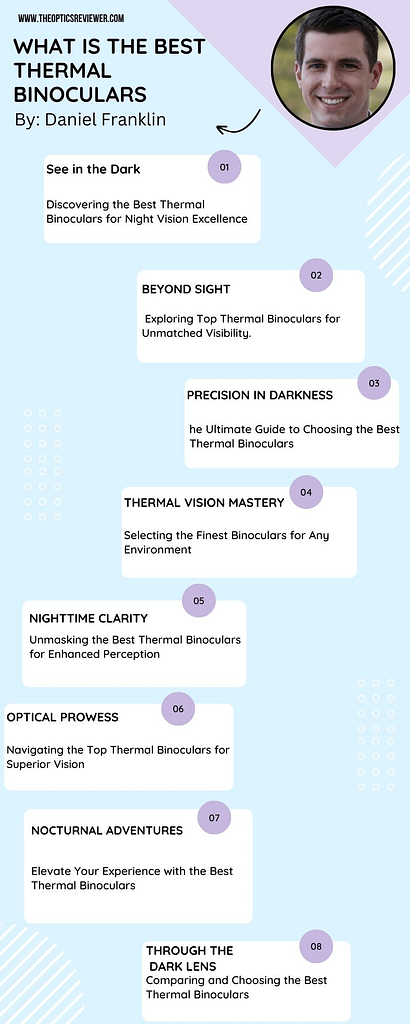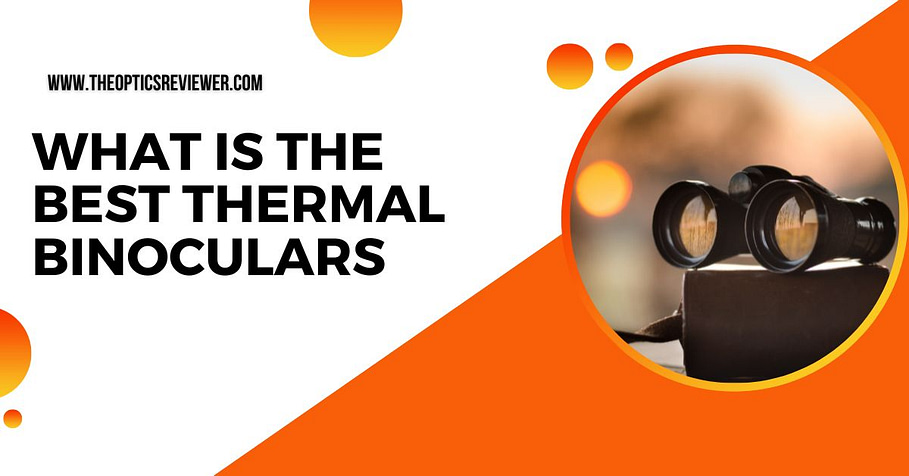When it comes to finding what is the best thermal binoculars, there are several factors to consider. From the top brands in the market to the main features that set them apart, making an informed decision can be a daunting task. Furthermore, understanding the differences between thermal binoculars and night vision binoculars is crucial.
In this discussion, we will explore these aspects and more, providing you with valuable insights into the world of thermal binoculars. So, whether you are an avid hunter, a nature enthusiast, or a security professional, stay tuned to discover the best thermal binoculars that meet your specific needs.
Contents
- 1 Key Takeaways
- 2 What is the Best Thermal Binoculars?
- 3 What are the Top Brands For Thermal Binoculars?
- 4 What are the Differences Between Thermal Binoculars and Night Vision Binoculars?
- 5 What are the Main Features to Consider When Choosing Thermal Binoculars?
- 6 What is the Price Range For Thermal Binoculars ?
- 7 What are the Most Affordable Thermal Binoculars on the Market?
- 8 What are the Pros and Cons of Thermal Binoculars?
- 9 Conclusion
- 10 References
- 11 Frequently Asked Questions
Key Takeaways
- ATN, FLIR, Pulsar, Moumi, and AGM are top brands offering a range of thermal binocular models with different features and performance levels.
- Thermal binoculars detect heat signatures, making them effective in complete darkness and dense foliage, while night vision binoculars amplify existing light and provide natural color representation.
- Thermal binoculars are useful in hunting, wildlife observation, law enforcement, and search and rescue missions, while night vision binoculars are crucial in military operations.
- When choosing thermal binoculars, factors to consider include image quality, detection range, durability, user-friendly features, and price range. Key features to consider include depth perception, adjustable focus, magnification power, image stabilization, and objective lens diameter.
What is the Best Thermal Binoculars?
To determine the best thermal binoculars for your specific needs, it is important to consider factors such as image quality, detection range, durability, and user-friendly features. When it comes to thermal binoculars, several top brands offer excellent options. Some of the best thermal binoculars on the market include models from FLIR, Pulsar, and ATN.
One of the main differences between thermal binoculars and night vision binoculars is the technology used. Thermal binoculars detect heat signatures and create an image based on the temperature differences, while night vision binoculars amplify existing light to provide visibility in low-light conditions.
When looking for the best thermal binoculars, there are a few key features to consider. Image quality is crucial, as you want clear and detailed visuals. Detection range is also important, as it determines how far you can see heat signatures. Durability is essential, especially if you plan to use the binoculars in rugged environments. Lastly, user-friendly features such as easy-to-use controls and intuitive menus can enhance the overall experience.
In terms of price range, thermal binoculars can vary greatly. Entry-level models can start around $1,000, while high-end professional-grade binoculars can go up to $10,000 or more. It’s important to set a budget and prioritize the features that are most important to you when making a decision.

What are the Top Brands For Thermal Binoculars?
When it comes to thermal binoculars, several top brands stand out for their exceptional imaging quality, advanced features, and suitability for various applications. Among these brands are ATN, FLIR, Pulsar, Moumi, and AGM. ATN offers a range of thermal binoculars, including the ATN BinoX 4T 640 and the ATN BinoX 4T 384, which are recognized for their imaging quality and features suitable for hunting and outdoor activities. FLIR, known for its thermal imaging technology, provides the FLIR Scout TK Handheld Thermal Imaging Monocular, a budget-friendly option for thermal imaging.
Pulsar, a prominent brand in the thermal imaging industry, offers premium thermal binoculars such as the Pulsar Merger LRF XP50 and the Pulsar Trionyx Multispectral Fusion, known for their advanced features and imaging capabilities. Moumi, on the other hand, offers the Moumi 8×52 Thermal Imaging Binoculars, recognized for their affordability and imaging quality. AGM provides the AGM Explorator FSB50-640, known for its quality and performance in the thermal imaging binoculars category.
When selecting thermal binoculars, key factors to consider include resolution, detection range, battery life, and durability. It is also important to compare the price range of thermal binoculars from different brands to ensure that you are getting the best value for your money.

What are the Differences Between Thermal Binoculars and Night Vision Binoculars?
Thermal binoculars and night vision binoculars differ in their underlying technology and the way they capture and display images in low-light or dark conditions. Thermal binoculars use thermal imaging technology to detect heat signatures emitted by living organisms and objects. They are effective in detecting wildlife in complete darkness or through dense foliage, making them suitable for wildlife observation. Night vision binoculars, on the other hand, amplify existing light to provide a clear image. They are commonly used in military operations, as they allow soldiers to navigate and spot targets in low-light conditions.
When it comes to wildlife observation, the choice between thermal and night vision binoculars depends on the specific needs and preferences of the user. Thermal binoculars are better at detecting animals hidden in dense vegetation or in complete darkness. Night vision binoculars, on the other hand, provide a more natural color representation and are better suited for observing animals in low-light conditions.
In law enforcement, thermal binoculars have various applications. They can aid in locating suspects or missing persons by detecting their heat signatures. Thermal binoculars are also useful for tracking criminals attempting to hide in the dark.
For hunting, thermal binoculars can be a game changer. They allow hunters to detect animals based on their heat signatures, providing an advantage in locating prey. However, some argue that thermal binoculars can be a gimmick, as they may not be necessary for all hunting situations.
In military operations, night vision binoculars play a crucial role. They enable soldiers to navigate and conduct operations in low-light or complete darkness. Night vision technology is also essential for reconnaissance and target acquisition.
In search and rescue missions, thermal binoculars are highly effective. They can help locate missing persons by detecting their body heat, even in challenging environments such as dense forests or at night. Night vision binoculars can also be useful in search and rescue operations, especially when there is some available ambient light.
If interested You can read more about what does 10×42 mean on binoculars.
What are the Main Features to Consider When Choosing Thermal Binoculars?
With the variety of thermal binoculars available on the market, it is essential to consider key features that will optimize your ability to detect and identify targets in various scenarios, such as hunting or surveillance. Thermal binoculars offer several advantages over thermal monoculars, including enhanced depth perception and a wider field of view.
When choosing thermal binoculars, adjustable focus is an important feature to consider. It allows you to focus on targets at different distances, ensuring clear and sharp images. Another crucial consideration is the magnification power of the binoculars. Higher magnification allows for detailed observation of distant targets, but it may also reduce the field of view. Image stabilization is an added benefit, as it reduces hand tremors and vibrations, resulting in a steadier view. Lastly, selecting the appropriate objective lens diameter is crucial.
A larger objective lens diameter allows more light to enter the binoculars, improving image brightness and clarity. However, it also increases the size and weight of the binoculars. Therefore, it is important to strike a balance between light-gathering capability and portability. By considering these key features, you can choose thermal binoculars that suit your specific needs and optimize your ability to detect and identify targets.
| Main Features to Consider | Importance | Considerations |
|---|---|---|
| Advantages of thermal binoculars over thermal monoculars | Enhanced depth perception and wider field of view | Consider your specific needs and the scenarios in which you will be using the binoculars |
| Importance of adjustable focus in thermal binoculars | Clear and sharp images at different distances | Ensure the binoculars have adjustable focus capabilities |
| Considerations for choosing the right magnification in thermal binoculars | Detailed observation of distant targets but reduced field of view | Strike a balance between magnification power and field of view |
| Benefits of image stabilization in thermal binoculars | Steadier view, reduced hand tremors and vibrations | Look for binoculars with image stabilization features |
| How to select the appropriate objective lens diameter for thermal binoculars | Improved image brightness and clarity but increased size and weight | Find a balance between light-gathering capability and portability |
What is the Price Range For Thermal Binoculars ?
The price range for thermal binoculars varies based on factors such as features, brand, and model, making it essential to consider your budget and specific needs before making a purchase. Budget-friendly options can be found in the range of $200 to $1000, offering basic thermal imaging capabilities suitable for night vision. These entry-level thermal binoculars or monoculars are a cost-effective choice for those who require basic thermal imaging functionality.
For those seeking improved imaging quality, detection range, and durability, mid-range models priced between $1000 to $5000 are available. These thermal binoculars offer better performance in low-light scenarios and are suitable for a variety of applications.
If interested you can read more about who invented the binoculars.
Premium and professional-grade thermal binoculars with advanced features, extended detection range, and superior imaging quality can be priced anywhere from $5000 to $15000 or more. These high-end thermal binoculars provide exceptional performance in low-light conditions and are ideal for professionals who require top-of-the-line imaging capabilities.
When choosing thermal binoculars, it is important to consider the difference between thermal binoculars and thermal monoculars. While thermal binoculars offer the benefit of depth perception and improved situational awareness, thermal monoculars are more compact and lightweight, making them a portable option.
Additionally, selecting the right magnification for thermal binoculars is crucial. Higher magnification allows for better detail identification, but it may come at the cost of a narrower field of view. It is important to find a balance that suits your specific needs.
Furthermore, weather conditions can have an impact on the performance of thermal binoculars. Fog, rain, and other atmospheric conditions can affect thermal imaging capabilities, so it is important to choose a model that is suitable for the environment in which it will be used.
To maintain and clean thermal binoculars, it is recommended to follow the manufacturer’s instructions. This may include using a soft cloth to clean the lenses and avoiding harsh chemicals that can damage the optics. Regular maintenance ensures optimal performance and extends the lifespan of the device.
Lastly, thermal binoculars have various applications across different industries. They can be used for surveillance, hunting, wildlife observation, search and rescue operations, and even in the military. Understanding the specific requirements of your industry or activity will help you choose the right thermal binoculars for your needs.
If interested you can read more about who makes cabelas binoculars.
What are the Most Affordable Thermal Binoculars on the Market?
Affordable thermal binocular options are available on the market, catering to those seeking budget-friendly choices for their thermal imaging needs. When considering the most affordable thermal binoculars, it is important to evaluate their performance, user reviews and ratings, longevity and durability, as well as additional accessories and features. Below is a comparison of some of the most affordable options:
| Model | Price Range | Performance | User Reviews and Ratings | Longevity and Durability | Additional Accessories and Features |
|---|---|---|---|---|---|
| Taipan TM15-384 | Below $1500 | Good performance | Positive ratings | Long-lasting | Various accessories included |
| AGM Cobra TB50-336 | Affordable | Reliable | Highly rated | Durable construction | Enhanced defense and security |
| Moumi 8×52 Thermal Imaging | More affordable | Decent performance | Positive feedback | Sturdy build | Budget-friendly choice |
| ATN BinoX THD Series | Competitive | Great features | Favorable reviews | High durability | Various advanced features |
These affordable thermal binoculars offer different price ranges and features, allowing users to find an option that suits their needs and budget. While the Taipan TM15-384 and AGM Cobra TB50-336 provide good performance and reliability, the Moumi 8×52 Thermal Imaging Binoculars stand out as a more budget-friendly choice.
The ATN BinoX THD Series, although not the least expensive, offers a competitive price considering its advanced features and durability. Users can refer to user reviews and ratings to gain insights into the performance and longevity of these affordable options. Additionally, the availability of various accessories and features further enhances the value and usability of these thermal binoculars.
If interested you can read more about are 80 x 80 binoculars good.
What are the Pros and Cons of Thermal Binoculars?
Thermal binoculars offer a range of benefits and drawbacks that should be considered when determining the best option for your needs. Here are some pros and cons to help you make an informed decision:
Conclusion
In conclusion, when it comes to What Is the Best thermal binoculars, there are several top brands available in the market, each with its own unique features and price range. The main factors to consider when choosing thermal binoculars include resolution, detection range, battery life, and durability.
While the price range for thermal binoculars can vary significantly, there are also affordable options available for those on a budget. Overall, selecting the best thermal binoculars depends on individual needs and preferences. As the saying goes, “The world is your oyster,” so explore the options and find the perfect thermal binoculars for your specific requirements.
References
- https://link.springer.com/article/10.1007/BF00235723
- https://link.springer.com/article/10.1007/BF00233186
- https://link.springer.com/article/10.1007/BF00237700
- https://link.springer.com/article/10.1007/BF00248796
Frequently Asked Questions
How Do Thermal Binoculars Work?
Thermal binoculars utilize thermal imaging technology to detect heat signatures through a heat detection mechanism. They employ infrared spectrum analysis and image processing algorithms to provide clear visuals. These binoculars find applications in military and law enforcement for surveillance and target identification.
Can Thermal Binoculars Be Used During the Day?
Thermal binoculars can be used during the day, offering advantages such as detecting hidden objects and identifying heat signatures. However, they have limitations in bright sunlight and differ from regular binoculars. Optimizing daytime use requires adjusting settings and using proper techniques. Comparatively, their effectiveness during the day and night may vary.
Are Thermal Binoculars Waterproof?
Thermal binoculars with waterproofing capabilities are essential for outdoor enthusiasts and professionals alike. The durability provided by waterproof features ensures optimal performance, allowing users to confidently navigate challenging environments and adverse weather conditions.
What Is the Maximum Detection Range of Thermal Binoculars?
The maximum detection range of thermal binoculars refers to their capabilities in identifying objects at long distances. These binoculars are designed to provide exceptional range performance, allowing users to observe targets effectively in various environments.
Can Thermal Binoculars Be Used for Hunting?
Thermal binoculars can be used for hunting, providing advantages such as improved target detection in low light conditions. However, they also have disadvantages, such as limited range and high cost. Other alternatives, like night vision binoculars, may be more popular depending on specific needs.

